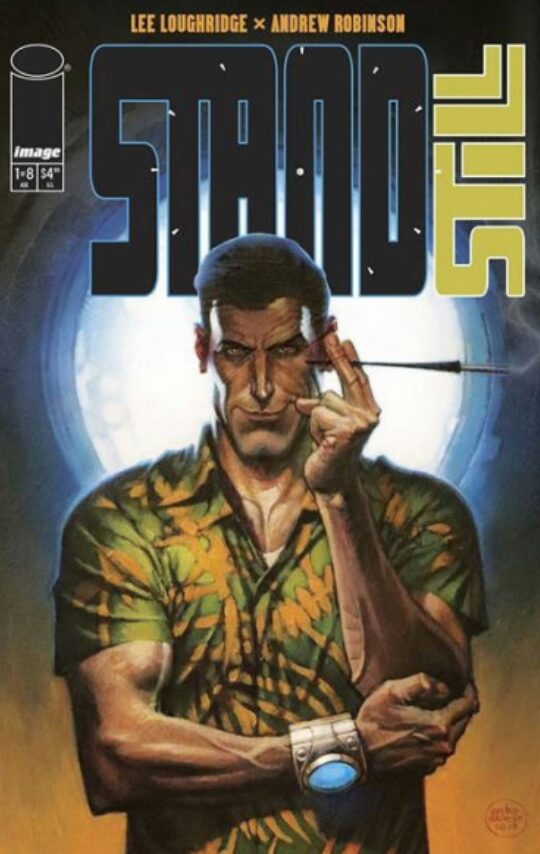
Standstill #1
Story & Color: Lee Loughridge
Art: Andrew Robinson
Design & Lettering: Rob Tweedie
Although Sir Isaac Newton’s studies are generally only attached to the world of applied sciences, his research revolving around the world of motion actually extends into the realm of social science as well. Especially his First Law of Motion that details the property of an object to stay at rest – or in motion – until acted upon by an outside force. In Standstill, a new series from Image Comics, all it takes is one technological advance to jumpstart things.
Standstill #1 opens by introducing readers to the “villain” of the series, although considering his actions in the opener that may not be a completely fair assessment. And while the first issue doesn’t give us the gentleman’s name, the series writer Lee Loughridge provides him with a personality that automatically brings a few choice ones to mind. Issue #1 introduces him to readers as he arrives at the Murder City Devils biker club and takes a seat at the bar. His drink orders are already a red flag but once the members take a look at his attire, which consists of flip flops and a Hawaiian shirt, they quickly decide he doesn’t belong there.
During their brief exchange he points out that the apparel the members sport is in fact a byproduct of Hollywood’s imagination. As several bikers begin to surround him, an obvious sign that he has overstayed his welcome and should leave, he goes on to explain how they owe their entire ensemble to Marlon Brando and the fetishizing of leather apparel. As disturbing as it is to the bikers to hear that their colors and cuts are also symbols of others PRIDE, what the mysterious man does to them next helps provide the main premise that exists within the pages of Standstill #1: Inertia. Specifically, how each individual and action factors into the equation.

We often only associate the phenomenon of inertia with physics or actions, but its attributes carry over into the realms of psychology and various other social sciences. Loughridge presents this to readers during our visit to the home of Colin Shaw. If you consider the Panama Jack character from above as an object in motion, then Shaw would be one at rest as well as in distress. At the moment it’s due to the realization his wife Lara is leaving him after spending “3 years in a Hick Town” all the while waiting for Shaw to get on with his life. A life she feels he should be out there enjoying after getting a large payout from the government for his last invention. But as he watches his wife pack up the last of her belongings before leaving for good, Colin attempts to explain one last time how he believes that his technology may be behind everything from government coups and to bank robberies taking place around the world. Unfortunately, all it takes is one panel from artist Andrew Robinson to inform Colin and the reader that Lara is no longer a part of his.
Image Comics Standstill feels like an R rated version of the film Clockstoppers. Those familiar with the film will even notice something later in the issue that wasn’t apparent in the opening sequence of the comic. During a plane flight the gentleman from the bar winds up sitting next to a rude and entitled man who is harassing the stewardess. After allowing his fellow passenger to act out long enough he activates his watch which creates a blue luminous light that envelops the surrounding area.

It seems in Standstill, much like the 2002 teen movie, someone – in this case most likely Shaw – invented a watch-like device capable of stopping time. In a similar nod to the film you may even notice that despite everyone always imagining the possibilities no one, including the government, really knows what to do when they finally have all the time in the world on their hands. Instead, Colin’s device was locked away like time in a bottle until someone finally took it off the government’s hands. Whether this was the mystery man or someone else is one of a few questions Standstill #1 will leave readers waiting to have answered.
Although they aren’t considered as complimentary the concept of perpetuation is closely associated with inertia. Loughridge and Robinson introduce it from the opening scene by having the bikers suggest that the gentleman’s outlandish outfit is evidence that he is out of the closet, only for him to destroy that stereotype with another. Standstill #1 even ends by starting the perpetual cycle of wondering how we can trust the government with dangerous technology before circling back after asking the question, who is it safer with? Image Comics latest series even perpetuates the conspiracies of connections between seemingly unrelated global events orchestrated by the few or even the one.
In fact it was this type of Beautiful Mind state that Colin Shaw stayed in for so long that led his wife Lana to consider her own mortality before ultimately deciding to move on. Leaving Colin in a new state, one that’s consistent with a how Standstill #1 asks each person, each particle to ponder, in terms of both efforts and existence.
Dust in the Wind.
Score: 8.6

